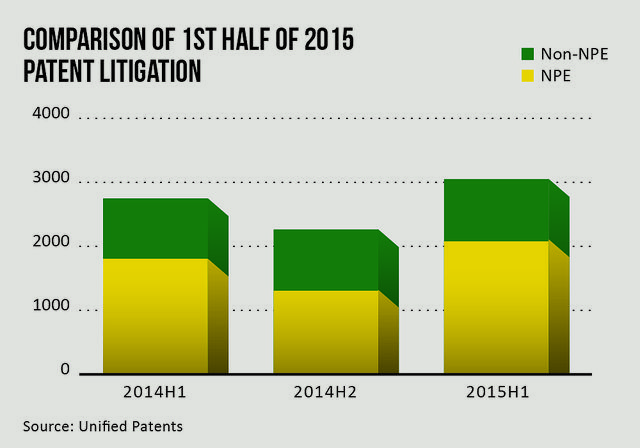Intellectual Property — Still in Search of Reform
Publication | 01.19.16
When Congress passed the America Invents Act (AIA) in 2011, there were high hopes that the first significant patent reform legislation in more than half a century would be just what was needed to discourage abuse and modernize the system, all the while striking the right balance between protecting inventors and promoting innovation well into the 21st century.
But 2015 brought an unprecedented wave of new calls for reform, and half a dozen new legislative proposals began circulating through Congress, largely focused on one of the most important issues of all—patent trolls. On one side, a coalition of businesses known as United for Patent Reform launched a major government relations campaign to encourage lawmakers to deter patent trolls by making it harder to bring patent infringement suits. On the other, major corporations, including pharmaceutical companies for which strong patent protection is their life's blood, are fighting to ensure strong patent protection. As the year drew to a close, none of the bills had emerged as a consensus frontrunner, setting the stage for a potential 2016 clash between some of the most powerful forces in Washington.
The debate over patent reform—and reform of our system of intellectual property in general—isn't going away, says Crowell & Moring Intellectual Property Group partner Teresa Rea, former acting and deputy director at the U.S. Patent & Trademark Office. "The IP discussion is going on among parties that never had to think about it before," she says. "There is no industry, no business—big or small—that has not been affected."
The key questions at play: how to craft anti-troll provisions such as limiting discovery, and shifting attorney's fees without harming those with a legitimate interest in protecting their patent rights.

Terry Rea.
PATENTS
Rea points out that the Founding Fathers actually identified patents in the U.S. Constitution because they wanted Americans to create and innovate with confidence. But in recent years, she says, patents have gotten a bad rap.
"They might not be able to tell you exactly why, but there is a growing public skepticism about the patent system, and the average person sometimes feels negatively about patents," says Rea. "Unfortunately, much of the public discourse surrounding reforms fails to recognize that we wouldn't be the country we are today without those protections for inventors." Some people may believe that patents are to blame for the high cost of prescription drugs. Or they've heard about patent "trolls," which hold patents not to make and sell a product, but to use them primarily as legal weapons against those who do, from tech giants to mom-and-pop restaurants, grocers, bookstores, and other retailers.
Broad concerns over trolls have recently led legislators in more than a dozen states to pass consumer protection laws that ban "bad faith patent assertions," Rea says, adding that while state-level legislation could help slow the pace of patent troll demand letters to small businesses, it has raised concerns that it could turn the patent system, generally considered federal domain, into an unwieldy patchwork of laws.
But pushing reform on the federal level is extremely complex, she notes, given the conflicting interests of some of the most powerful industry voices. Pharmaceutical interests that pour billions into research and development need strong patent protection for as long as possible, as they make most of their investment back in the later years of the patent term. In the technology sector, where new inventions regularly become obsolete in a few years, many firms only see a need for shorter patent terms. "Every proposal is seen as benefiting one side or the other," says Rea. "That makes consensus-building very difficult."
And Congress has to be extremely careful about the unintended consequences of any reform provision. For example, while a system in which the loser pays court costs could discourage frivolous patent lawsuits, it also could hurt universities and other nonprofit entities that, like trolls, develop and hold patents not for the purpose of making and selling products but to license them to others.
"In our system, we want you to be able to assert your rights if you truly feel you have a legal right that is being compromised and not be reluctant to bring that claim because you might have to pay the other side's legal costs," Rea says.
Reforms passed in 2011 have already resulted in at least one unintended consequence: while the Patent Trial and Appeal Board (PTAB) was created under the AIA to make it quicker and cheaper to challenge weak patents, its popularity as a new forum has raised concerns that it may be being used for purposes beyond challenging patent validity, such as to raise issues about the strength of a company's patent portfolio or to mire patent holders in endless litigation. "Sorting out the bad actors from the good actors is very difficult," says Rea.
BEYOND PATENTS
Rea says the pace of change worldwide also poses challenges for our entire system of intellectual property. For example, while the Digital Millennium Copyright Act, passed in 1998, was supposed to protect copyright holders from online pirates well into the new century, less than two decades in, Congress is already considering significant changes to the copyright system.
And while trade secret law has traditionally been the domain of the states, concerns about international trade secret theft have prompted congressional proposals for a new federal trade secret law. In an effort to focus on this important issue and protect American innovation, Congress created the Office of Intellectual Property Enforcement Coordinator in 2008. Its new IP czar, Daniel Marti, promised in 2015 to develop a set of legislative recommendations and executive actions aimed at beefing up protection for trade secrets.
"The debate is more robust than ever," says Rea. "But it's also more complex. With IP, it always needs to be about where the balance should be so that we never lose the incentive to innovate in this country.

[Of the 3,050 patent lawsuits filed in the first half of last year, 2,075, or 68 percent, were filed by non-practicing entities (NPEs).]
On the Docket
At least six major patent reform bills were introduced in Congress in 2015—and may move forward in 2016
Innovation Act
A bipartisan bill with 19 co-sponsors, the Innovation Act calls for a wide variety of reforms including raising pleading requirements, limiting discovery, and fee shifting.
PATENT Act
The Protecting American Talent and Entrepreneurship Act is basically the Senate version of the Innovation Act, with some minor differences.
STRONG Act
The Support Technology and Research for Our Nation's Growth Act was filed by opponents of the Innovation Act. Seen as pro-patent owner, it would primarily make changes to the USPTO patent review process.
TROL Act
The Targeting Rogue and Opaque Letters Act is similar to some state legislation that punishes those that send bad-faith enforcement letters.
Demand Letter Transparency Act
Sets minimum content requirements for demand letters and requires those sending more than 20 to file them in a national public database.
Innovation Protection Act
Blocks Congress from diverting excess USPTO fees toward other purposes.
[PDF Download: 2016
|
|
[Web Index: 2016 Regulatory
|
Contacts
Insights
Publication | May 25-27, 2008
“ISI mitigation using bit-edge equalization in high-speed backplane data transmission,” in IEEE International Conference on Communications, Circuits and Systems (ICCCAS 2008), pp. 589 - 593.
Publication | 04.10.24
Publication | 2023
Publication | 04.02.24
Conservation Easement Ruling Signals More APA Challenges Ahead



